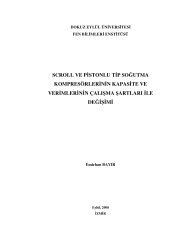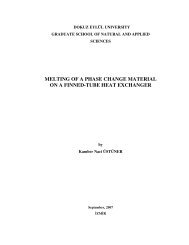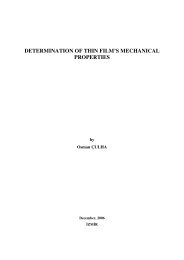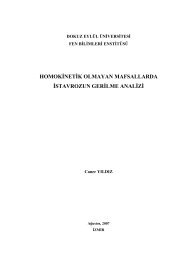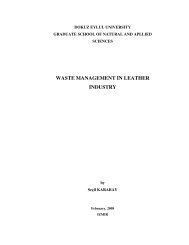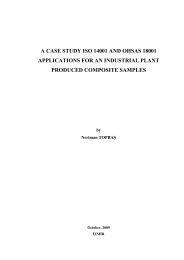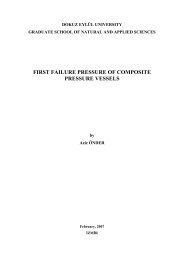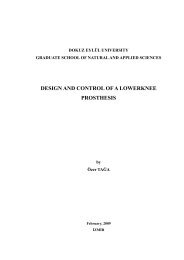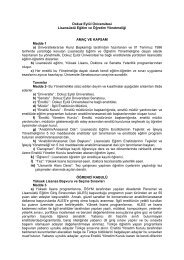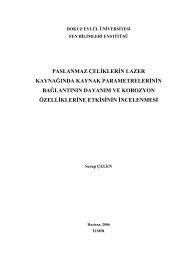A numerical study on the thermal expansion coefficients of fiber
A numerical study on the thermal expansion coefficients of fiber
A numerical study on the thermal expansion coefficients of fiber
Create successful ePaper yourself
Turn your PDF publications into a flip-book with our unique Google optimized e-Paper software.
34<br />
absolute accuracy <strong>of</strong> about ± 0.2 x 10 -6 K -1 . Thus over large temperature ranges, <strong>the</strong><br />
absolute accuracy can be better than this, and over smaller temperature ranges, ra<strong>the</strong>r<br />
worse. The accuracy is best treated in this manner, because <strong>the</strong> limiting mechanical<br />
instabilities are present whatever <strong>the</strong> expansi<strong>on</strong> coefficient <strong>of</strong> <strong>the</strong> material, and <strong>the</strong><br />
sensitivity factor (a single temperature independent figure) can usually be determined<br />
ra<strong>the</strong>r more accurately than <strong>the</strong> o<strong>the</strong>r temperature dependent factors (Morrell, R.<br />
1997).<br />
The push-rod in a mechanical dilatometer normally applies a compressive axial<br />
force <strong>on</strong> <strong>the</strong> test-piece to maintain c<strong>on</strong>stant c<strong>on</strong>tact. Typically this force is 0.5 – 2 N,<br />
but may be less if a balanced <strong>the</strong>rmomechanical analyzer type <strong>of</strong> apparatus is used.<br />
This force may be sufficient to induce permanent distorti<strong>on</strong> in composites when <strong>the</strong><br />
matrix phase s<strong>of</strong>tens. In polymer-based systems, this can happen above 150°C, and<br />
in aluminum alloy based metal-matrix composites, above about 450°C. The<br />
distorti<strong>on</strong> may be limited to "bedding down" <strong>of</strong> <strong>the</strong> c<strong>on</strong>tact surfaces, but in some<br />
cases, may induce bulk creep effects. The progressive "ratcheting" seen in repeat<br />
<strong>the</strong>rmal cycling <strong>of</strong> some composites may in part be attributable to creep effects. The<br />
effects tend to be negligible parallel to <strong>the</strong> reinforcement directi<strong>on</strong>s in l<strong>on</strong>g-<strong>fiber</strong><br />
composites, but may be c<strong>on</strong>siderable across ply structures in 2D laminates (Morrell,<br />
R. 1997).<br />
3.3.2 Interferometry<br />
This is a potentially much more accurate method for determining <strong>the</strong>rmal<br />
expansi<strong>on</strong>. A coherent light source is split and reflected <strong>of</strong>f surfaces at each end <strong>of</strong><br />
<strong>the</strong> test-piece, and <strong>the</strong>n recombined. As <strong>the</strong> test-piece expands, <strong>the</strong> level <strong>of</strong><br />
interference between <strong>the</strong> recombined beams changes, and <strong>the</strong> total expansi<strong>on</strong> can be<br />
determined by counting <strong>the</strong> number <strong>of</strong> dark fringes detected. One fringe corresp<strong>on</strong>ds<br />
to a test-piece end-face relative displacement <strong>of</strong> l/4. For a calibrated wavelength, <strong>the</strong><br />
method is potentially absolute, and needs no correcti<strong>on</strong> factors. Displacements as<br />
small as l/1000 can be resolved with certain types <strong>of</strong> interferometer (Morrell, R.<br />
1997). However, <strong>the</strong> quality <strong>of</strong> <strong>the</strong> test-piece surfaces is a key issue. They normally



